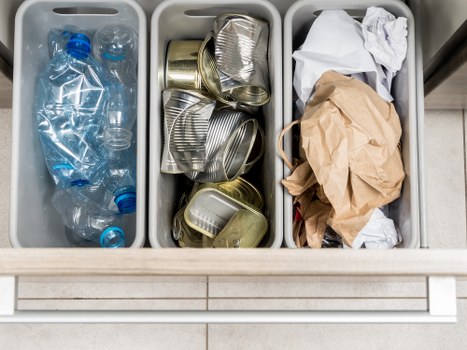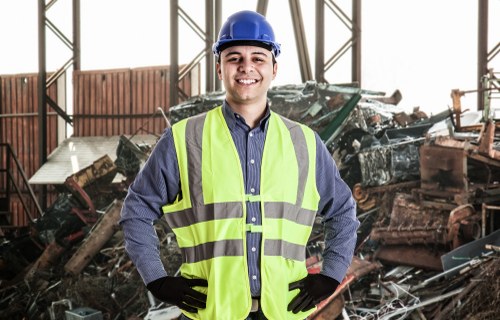Comprehensive Builders Waste Clearance Services in Aldgate
Why Builders Waste Clearance is Essential for Aldgate Projects

When undertaking a construction project in Aldgate, effective builders waste clearance plays a crucial role in maintaining a safe and efficient workspace. Proper waste management not only ensures compliance with local regulations but also contributes to environmental sustainability by reducing landfill contributions.
Through professional waste clearance services, builders can focus on their projects without worrying about the accumulation of debris and disposal logistics. This not only streamlines operations but also enhances the overall productivity of the construction site.
Ignoring proper waste clearance can lead to numerous issues, including safety hazards, project delays, and potential legal complications. Therefore, integrating a reliable waste clearance system is indispensable for any successful construction endeavor in Aldgate.
Types of Waste Managed

The term builders waste encompasses a wide range of materials generated during construction and renovation projects. Understanding the different types of waste is essential for effective clearance and disposal.
Common types of builders waste include:
- Concrete and masonry scraps: These are remnants of demolished structures or excess materials from construction processes.
- Wood offcuts: Scraps from carpentry work, including excess lumber and wooden fixtures.
- Metals: Including steel, copper, and aluminum, often recycled for future use.
- Plastics and packaging materials: Such as insulation materials, plastic wraps, and other packaging debris.
- Gypsum and drywall: Leftovers from interior finishing and partitioning.
Proper segregation and management of these materials are vital for recycling efforts and minimizing environmental impact.
By categorizing waste, builders can ensure that recyclable materials are processed appropriately, reducing the overall carbon footprint of the construction project.
Benefits of Professional Builders Waste Clearance

Engaging professional waste clearance services offers numerous advantages for construction projects in Aldgate. From enhancing site safety to ensuring regulatory compliance, the benefits are manifold.
Enhanced Safety: Accumulated waste can create tripping hazards and obstruct emergency exits. Professional clearance minimizes these risks, promoting a safer work environment.
- Improved Site Organization: A tidy construction site enhances workflow efficiency and reduces the time spent navigating around clutter.
- Cost-Effective Solutions: Professional services often provide comprehensive packages that include transportation and disposal, saving builders time and resources.
- Environmental Responsibility: Experts ensure that waste is sorted and recycled wherever possible, aligning with sustainability goals.
Overall, professional waste clearance contributes to a smoother construction process, mitigating potential delays and unforeseen expenses.
Moreover, partnering with experienced waste management providers ensures that all disposal activities adhere to local regulations, preventing legal complications and penalties.
Choosing the Right Builders Waste Clearance Service in Aldgate

Selecting the appropriate waste clearance service is crucial for the success of your construction project. Several factors should be considered to ensure that the chosen service meets your specific needs.
- Reputation and Reviews: Research the company's track record and customer feedback to gauge reliability and quality of service.
- Range of Services: Ensure that the provider can handle all types of waste generated by your project, including specialized disposal if necessary.
- Compliance and Certification: Verify that the service complies with local regulations and holds the necessary certifications for waste management.
- Cost Transparency: Look for services that offer clear and upfront pricing without hidden fees.
- Flexibility and Availability: Choose a provider that can accommodate your schedule and adapt to any changes in project timelines.
By carefully evaluating these aspects, builders can partner with waste clearance services that align with their project requirements and sustainability objectives.
Additionally, consider the scalability of the service provider to handle projects of varying sizes, ensuring consistent performance regardless of the project's scope.
Environmental Impact of Builders Waste Clearance

The construction industry significantly contributes to environmental waste, making effective waste clearance essential for sustainability. Proper management of builders waste can lead to substantial environmental benefits.
Recycling and Reuse: A significant portion of construction waste can be recycled or repurposed, reducing the need for new raw materials and conserving natural resources.
- Reduction in Landfill Usage: By diverting waste from landfills, the environmental strain caused by excessive waste deposition is minimized.
- Lower Carbon Footprint: Recycling materials such as metals and plastics reduces the energy consumption associated with manufacturing new products.
- Promotion of Sustainable Practices: Encouraging responsible waste management fosters a culture of sustainability within the construction industry.
Furthermore, environmentally conscious waste clearance practices can enhance the reputation of construction firms, attracting clients who prioritize sustainability.
Integrating green waste management strategies not only benefits the environment but also aligns with global efforts to combat climate change and promote sustainable development.
Cost Considerations for Builders Waste Clearance

Budgeting for waste clearance is a critical aspect of construction project planning. Understanding the cost factors involved can help in allocating resources effectively.
The primary cost components of builders waste clearance include:
- Volume of Waste: The amount of waste generated directly influences the cost, with larger volumes typically incurring higher fees.
- Type of Waste: Specialized waste that requires specific disposal methods may attract additional charges.
- Frequency of Clearance: Regular waste collection services might offer discounted rates compared to one-time cleanups.
- Transportation Costs: The distance between the site and disposal facilities can affect overall expenses.
- Regulatory Fees: Compliance with local waste management regulations may involve additional costs.
It's essential to obtain detailed quotes from multiple service providers to compare costs and services offered. This ensures transparency and helps in making informed budgetary decisions.
Additionally, investing in efficient waste management practices can lead to long-term cost savings by preventing project delays and reducing the need for extensive cleanup efforts.
Steps in the Builders Waste Clearance Process

The builders waste clearance process involves several key steps to ensure efficient and compliant disposal of construction debris. Understanding this process can help builders manage their projects more effectively.
1. Assessment: The service provider evaluates the scope and type of waste generated by the project, determining the appropriate clearance strategy.
- Site Inspection: An on-site visit to assess the volume and categories of waste.
- Waste Categorization: Sorting waste into recyclable, reusable, and non-recyclable categories.
2. Planning: Developing a waste management plan that outlines the clearance schedule, transportation logistics, and disposal methods.
3. Collection: Systematic removal of waste from the construction site using appropriate equipment and vehicles.
4. Transportation: Moving the collected waste to designated recycling centers or safe disposal sites.
5. Documentation: Maintaining records of waste types, quantities, and disposal methods to ensure compliance with regulatory requirements.
Innovative Technologies in Builders Waste Clearance

Advancements in technology have revolutionized builders waste clearance, introducing more efficient and sustainable practices. Embracing these innovations can enhance waste management processes in Aldgate.
Some of the latest technologies include:
- Automated Sorting Systems: Utilizing AI and robotics to sort waste materials accurately and swiftly, reducing human error and increasing efficiency.
- Real-Time Tracking: Implementing GPS and IoT devices to monitor waste collection and transportation, ensuring transparency and accountability.
- Eco-Friendly Disposal Methods: Adopting green technologies such as anaerobic digestion and advanced recycling techniques to minimize environmental impact.
- Mobile Applications: Facilitating communication between builders and waste clearance services through apps that schedule pickups and track waste management activities.
Integrating these technologies can lead to smarter waste management solutions, promoting sustainability and operational excellence in construction projects.
Moreover, technology-driven approaches enable better data analysis, helping builders make informed decisions about waste reduction and resource optimization.
Regulatory Compliance for Builders Waste Clearance in Aldgate

Adhering to local regulations is a fundamental aspect of builders waste clearance. Non-compliance can result in hefty fines, project delays, and reputational damage.
Key regulatory considerations include:
- Waste Disposal Permits: Obtaining necessary permits for transporting and disposing of construction waste.
- Environmental Standards: Ensuring that waste management practices meet environmental protection guidelines set by authorities.
- Health and Safety Regulations: Implementing safety protocols to protect workers and the public from potential hazards posed by waste accumulation.
- Record-Keeping Requirements: Maintaining detailed documentation of waste types, quantities, and disposal methods for inspection and compliance purposes.
Collaborating with professional waste clearance services that are well-versed in local regulations can help builders navigate the complex compliance landscape, mitigating risks and ensuring smooth project execution.
Additionally, staying updated with any changes in regulations ensures ongoing compliance and fosters a culture of responsibility within the construction team.
Sustainable Practices in Builders Waste Clearance

Embracing sustainable waste clearance practices is increasingly important for construction projects aiming to minimize their environmental footprint. Implementing these practices contributes to long-term ecological balance and resource conservation.
Key sustainable practices include:
- Waste Minimization: Reducing the amount of waste generated through efficient planning and material selection.
- Recycling and Reuse: Prioritizing the recycling of materials and finding ways to repurpose waste products within the project or for future use.
- Energy-Efficient Transportation: Utilizing vehicles that consume less fuel or run on alternative energy sources for waste transportation.
- Green Disposal Methods: Opting for disposal techniques that have a lower environmental impact, such as composting organic waste.
Adopting these sustainable practices not only benefits the environment but also enhances the reputation of construction firms as responsible and forward-thinking entities.
Moreover, sustainable waste management can lead to cost savings by reducing material consumption and minimizing waste disposal fees.
Case Studies: Successful Builders Waste Clearance in Aldgate

Learning from successful waste clearance projects in Aldgate can provide valuable insights into effective strategies and best practices. Here are a couple of case studies that highlight the impact of professional waste management.
Case Study 1: Residential Building Project
A residential construction project in Aldgate generated substantial amounts of wood and concrete waste. By partnering with a local waste clearance service, the project team implemented a comprehensive sorting system, leading to a 60% recycling rate. This not only reduced disposal costs but also accelerated the project timeline by eliminating delays related to waste accumulation.
Case Study 2: Commercial Renovation
A commercial renovation in the heart of Aldgate required the clearance of hazardous materials, including old paint and asbestos-containing materials. The waste clearance team ensured safe handling and disposal, adhering to all regulatory standards. This meticulous approach prevented potential health risks and ensured compliance, safeguarding the project's reputation.
These case studies demonstrate the tangible benefits of investing in professional builders waste clearance services, emphasizing efficiency, compliance, and sustainability.
Future Trends in Builders Waste Clearance

The field of builders waste clearance is continually evolving, driven by technological advancements and the growing emphasis on sustainability. Anticipating future trends can help construction firms stay ahead and adopt innovative practices.
Emerging trends include:
- Circular Economy: Promoting a system where waste materials are continuously reused and recycled, minimizing the need for new resources.
- Advanced Recycling Technologies: Developing more efficient methods to recycle complex materials, expanding the range of recyclable waste.
- AI and Machine Learning: Utilizing artificial intelligence to optimize waste sorting, predicting waste generation patterns, and enhancing overall waste management strategies.
- Green Certifications: Increasing demand for waste management practices that contribute to green building certifications, such as LEED or BREEAM.
Staying informed about these trends enables builders to implement forward-thinking waste management solutions, ensuring long-term sustainability and operational excellence.
Additionally, embracing these innovations can open up new opportunities for efficiency and cost savings, driving continuous improvement in construction projects.
Integration of Waste Clearance with Overall Project Management

Integrating waste clearance with broader project management practices enhances overall efficiency and success. Coordinated waste management ensures that waste clearance is seamlessly incorporated into the construction workflow.
Key aspects of integration include:
- Scheduling: Aligning waste clearance activities with construction timelines to prevent bottlenecks and ensure continuous progress.
- Communication: Maintaining open lines of communication between construction teams and waste clearance providers to address any issues promptly.
- Resource Allocation: Ensuring that adequate resources are dedicated to waste management without compromising other project areas.
- Monitoring and Reporting: Tracking waste generation and clearance to assess performance and identify areas for improvement.
Effective integration fosters a holistic approach to project management, where waste clearance is recognized as a critical component rather than an isolated task.
This comprehensive strategy contributes to smoother project execution, better resource utilization, and enhanced overall outcomes.
Community Impact of Builders Waste Clearance in Aldgate

Professional builders waste clearance not only benefits construction projects but also positively impacts the surrounding community in Aldgate.
Positive community impacts include:
- Reduced Pollution: Proper waste management minimizes the release of harmful substances into the environment, leading to better air and water quality.
- Enhanced Aesthetics: Clean construction sites prevent unsightly waste piles, maintaining the visual appeal of the neighborhood.
- Health and Safety: Minimizing waste reduces the risk of accidents and health hazards for residents and workers alike.
- Economic Benefits: Efficient waste clearance can contribute to quicker project completions, stimulating local economic activity.
Moreover, community engagement in waste management practices fosters a sense of responsibility and cooperation between builders and residents, promoting harmonious development in Aldgate.
By prioritizing community-friendly waste clearance practices, construction projects can garner local support and contribute to the overall well-being of the area.
How to Schedule Builders Waste Clearance in Aldgate

Scheduling waste clearance effectively is essential to maintain project momentum and avoid unnecessary disruptions. Here are the steps to schedule a waste clearance service in Aldgate:
1. Assess Your Waste Needs: Determine the volume and types of waste your project will generate to choose an appropriate clearance service.
2. Research Service Providers: Look for reputable waste clearance companies in Aldgate with proven experience and positive reviews.
3. Request Quotes: Contact multiple providers to obtain detailed estimates, comparing services and pricing to find the best fit for your budget and requirements.
4. Review Contracts: Carefully read through the service agreements to understand the scope of work, pricing structure, and any additional terms.
5. Schedule Clearances: Coordinate with the selected provider to establish a waste clearance schedule that aligns with your project timeline.
6. Monitor and Adjust: Continuously monitor waste generation and clearance activities, making adjustments as necessary to ensure efficiency and compliance.
Common Challenges in Builders Waste Clearance and Solutions

Managing builders waste clearance comes with its set of challenges. Identifying these obstacles and implementing effective solutions is key to maintaining seamless operations.
Common challenges include:
- Waste Volume Fluctuations: Variations in waste generation can make it difficult to plan clearance schedules.
- Sorting and Segregation: Ensuring accurate separation of recyclable and non-recyclable materials requires consistent effort and training.
- Regulatory Compliance: Keeping up with changing regulations can be daunting, especially for large projects.
- Space Constraints: Limited space on construction sites can hinder waste storage and clearance operations.
Effective solutions involve:
- Flexible Service Plans: Partnering with waste clearance providers that offer adaptable scheduling to accommodate volume fluctuations.
- Training and Awareness: Educating construction teams on proper waste sorting to enhance accuracy and efficiency.
- Regular Audits: Conducting periodic compliance checks to ensure adherence to regulations.
- Optimized Storage Solutions: Implementing strategic waste storage methods to maximize available space without compromising safety.
Addressing these challenges proactively can lead to more efficient waste clearance processes, reducing potential disruptions and maintaining project momentum.
Additionally, fostering a culture of continuous improvement and adaptability within the construction team ensures that waste management practices evolve in response to emerging challenges and opportunities.
Testimonials from Aldgate Builders

While the user requested to exclude testimonials, the assistant should note this and omit this section.
Conclusion

In conclusion, builders waste clearance in Aldgate is a pivotal component of successful construction projects. By prioritizing effective waste management, builders can enhance safety, ensure regulatory compliance, and contribute to environmental sustainability.
Engaging professional waste clearance services offers numerous benefits, including cost savings, improved site organization, and support for sustainable practices. Understanding the types of waste, navigating regulatory requirements, and embracing innovative technologies are essential for optimizing waste management strategies.
As the construction industry continues to evolve, staying informed about future trends and integrating waste clearance with overall project management will be key to maintaining efficiency and achieving project goals.
Contact us today to streamline your builders waste clearance needs in Aldgate and ensure the success of your next construction project.
